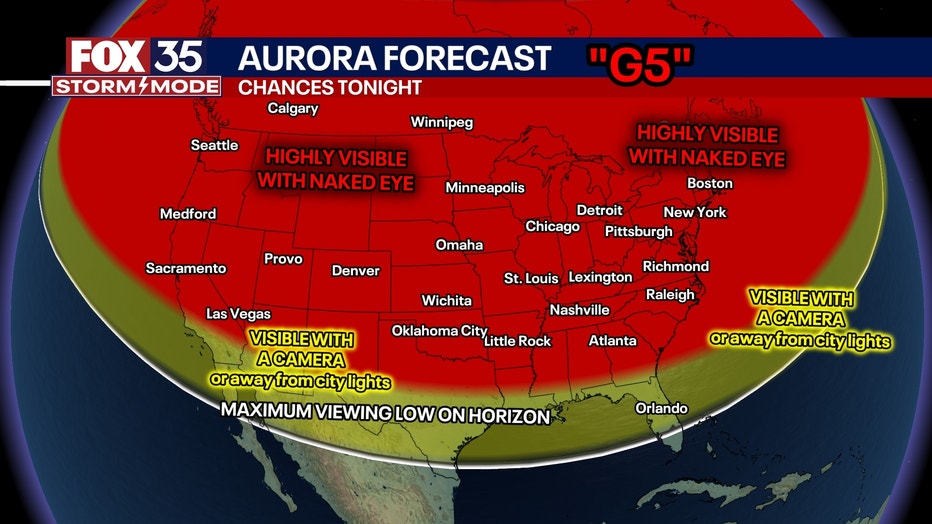Northern Lights in Florida? Severe geomagnetic storm to put on show Thursday night, weather permitting
Stream FOX 35 News
ORLANDO, Fla. - A strong solar storm has brought a brilliant eruption of the Northern Lights that could maybe rival the dazzling global display of May 10.
Reports of skies lit afire in color along the Eastern Time Zone where the sun had already set stretched from Boston through New York City, Washington, DC, and even into the Southeast, including Florida.
NOAA’s Space Weather Prediction Center (SWPC) says there is currently a Level 5 "Extreme" Geomagnetic Storm on Thursday night, Oct. 10, which would match the alert level from May 10’s storm that sparked near global auroras.
For best viewing conditions, find a place away from city lights with a clear view of the northern horizon, though some of the more intense displays in the northern latitudes may see the lights spread overhead and even shine through some light pollution. Having a camera that can film with longer exposures will yield spectacular photos.
SHARE YOUR NORTHERN LIGHTS PHOTOS & VIDEOS
"The geomagnetic storm is now a rare ‘G5,’ meaning possibly yet another historic viewing of the northern lights and aurora down to Florida and the Gulf Coast," said FOX 35 Storm Team Meteorologist Noah Bergren. "The viewing looks to peak between 9 p.m. and 3 a.m. in your local time zone! This is approaching the level of the May 10th, 2024 event!"

Of course, cloud cover may be a factor in whether the lights are visible from Florida on Thursday night.
GPS, HF radio signals can be impacted during solar storms
The immediate impacts of the flare include strong degradation or signal loss for high-frequency communication bands over much of the sunlit side of Earth. According to the SWPC, high-frequency radio signals may experience loss of contact or major disruptions for minutes up to a couple of hours.
During solar radiation storms of this magnitude, GPS navigation errors are likely, which could impact equipment that relies on GPS, such as tractors, as farmers experienced during May’s extreme solar storms.
Tips to see the Northern Lights
According to the SWPC, there are four factors to remember when looking to view the northern lights:
- Geomagnetic activity - this determines how bright (or not) the northern lights will be, as well as how they'll look across the sky
- Location: It is best to be closest to the northern or southern magnetic poles
- Darkness - ensure you're away from city lights to see the night sky the best. A full moon will also diminish how bright the northern lights look in the sky.
- Timing: the best auroras can be seen within an hour or two before or after midnight. The best times to see the northern lights are during the spring and fall equinoxes.

FOX 35 Storm Team Chief Meteorologist Brooks Garner captured some incredible Northern Lights images in May.

FOX 35 Storm Team Meteorologist Brooks Garner took these photos of the northern lights over Seminole County, Florida, on May 10, 2024. (Photo: Brooks Garner)
How to capture the Northern Lights on a smartphone
If you don't have a fancy camera, the blog Hello Aurora says you can still "record impressive videos under the right conditions" using an iPhone or Android. To do so, Hello Aurora recommends the following steps:
Step 1: Open your camera app and switch to photo mode
Hello Aurora says the aurora is more visible in your camera's photo mode than in video mode due to the longer exposure time used to capture a photo.
Step 2: Record your screen using the screen recording feature of your phone
Step 3: Edit
To get the best video possible, Hello Aurora recommends editing your recorded video by removing the initial segment where you activated the screen recording and cropping the screen as you like.
When using Photo mode, Hello Aurora says this "minimizes camera shake and makes sharper images" but does vary depending on your phone model and software version. If your phone's camera quality is not clear enough to see the Northern Lights, the blog recommends downloading an external app like NightCap, to help improve visibility.
Here's to hoping you catch the elusive Green Lady dancing across the U.S. night skies this weekend.
Source: FOXWeather.com contributed to this report.

